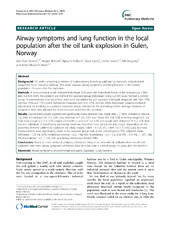| dc.description.abstract | Background: Oil tanks containing a mixture of hydrocarbons, including sulphuric compounds, exploded and caught fire in an industrial harbour. This study assesses airway symptoms and lung function in the nearby population 1½ years after the explosion. Methods: A cross-sectional study included individuals ≥18 years old. Individuals living <6 km (sub-groups <3km and 3–6 km) from the accident site formed the exposed group, individuals living >20 km away formed a control group. A questionnaire and spirometry tests were completed by 223 exposed individuals (response rate men 70%, women 75%) and 179 control individuals (response rate men 51%, women 65%). Regression analyses included adjustment for smoking, occupational exposure, atopy, infection in the preceding month and age. Analyses of symptoms were also adjusted for stress reactions related to the accident. Results: Exposed individuals experienced significantly more blocked nose (odds ratio 1.7 [95% confidence interval 1.0, 2.8]), rhinorrhoea (1.6 [1.1, 3.3]), nose irritation (3.4 [2.0, 5.9]), sore throat (3.1 [1.8, 5.5]), morning cough (3.5 [2.0, 5.5]), daily cough (2.2 [1.4, 3.7]), cough >3 months a year (2.9 [1.5, 5.3]) and cough with phlegm (1.9 [1.2, 3.1]) than control individuals. A significantly increasing trend was found for nose symptoms and cough, depending on the proximity of home address to explosion site (daily cough, 3-6km 1.8 [1.0, 3.1], <3km 3.0 [1.7, 6.4]). Lung function measurements were significantly lower in the exposed group than in the control group, FEV1 adjusted mean difference −123 mL [95% confidence interval −232, -14]), FEV1% predicted −2.5 [−5.5, 0.5], FVC −173 mL [− 297, -50], FVC% predicted −3.1 [− 5.9, -0.4], and airway obstruction (GOLD II/III). Conclusions: Based on cross sectional analyses, individuals living in an area with air pollution from an oil tank explosion had more airway symptoms and lower lung function than a control group 1½ years after the incident. | en_US |

